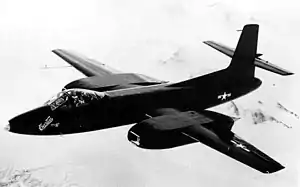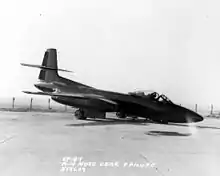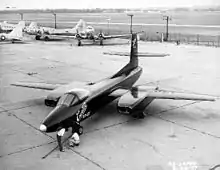Curtiss-Wright XF-87 Blackhawk
The Curtiss-Wright XF-87 Blackhawk (previously designated the XP-87) was a prototype American all-weather jet fighter interceptor and the company's last aircraft project.[1] Designed as a replacement for the World War II–era propeller-driven P-61 Black Widow night/interceptor aircraft, the XF-87 lost in government procurement competition to the Northrop F-89 Scorpion. The loss of the contract was fatal to the company; the Curtiss-Wright Corporation closed down its aviation division, selling its assets to North American Aviation.
| XF-87 Blackhawk | |
|---|---|
 | |
| Role | Interceptor |
| Manufacturer | Curtiss-Wright |
| First flight | 5 March 1948 |
| Status | Canceled 10 October 1948 |
| Primary user | U.S. Air Force |
| Number built | 2 |
Design and development
The aircraft started life as a project for an attack aircraft, designated XA-43. When the United States Army Air Forces issued a requirement for a jet-powered all-weather fighter in 1945, the design was reworked for that request.
The XP-87 was a large mid-wing aircraft with four engines paired in underwing pods, with a mid-mounted tailplane and tricycle undercarriage. Two crew members (pilot and radar operator) sat side by side under a single canopy. Armament was to be a nose-mounted, powered turret containing four 20 mm (0.79 in) cannon, but this was never fitted to the prototypes. Instead the aircraft was armed with four fixed forward firing 20mm cannon.[2]
Operational history
The first flight of the XF-87 Blackhawk was on 5 March 1948.[3] Although the top speed was slower than expected, the aircraft was otherwise acceptable, and the newly formed (in September 1947) United States Air Force placed orders for 57 F-87A fighters and 30 RF-87A reconnaissance aircraft just over a month later. Since the performance problems were due to lack of power, the four Westinghouse XJ34-WE-7 turbojets of the prototypes were to be substituted for two General Electric J47 jets in production models. One of the two XF-87 prototypes was to be modified as a test bed for the new engines.
At this point, the USAF decided that the Northrop F-89 Scorpion was a more promising aircraft. The F-87 contract was cancelled on 10 October 1948, and both prototypes were scrapped.
Variants


- XP-87
- First flight was March 5, 1948
- XF-87
- Redesignated XP-87
- F-87A
- Production fighter version (canceled)
- RF-87A
- Reconnaissance variant (canceled)
Specifications (XF-87 No.1)
Data from Curtiss Aircraft 1907–1947[4]
General characteristics
- Crew: 2
- Length: 62 ft 10 in (19.15 m)
- Wingspan: 60 ft 0 in (18.29 m)
- Height: 20 ft 0 in (6.10 m)
- Wing area: 600 sq ft (56 m2)
- Empty weight: 25,930 lb (11,762 kg)
- Gross weight: 49,900 lb (22,634 kg)
- Powerplant: 4 × Westinghouse XJ34-WE-7 turbojet engines, 3,000 lbf (13 kN) thrust each
Performance
- Maximum speed: 600 mph (970 km/h, 520 kn) at sea level
- Range: 1,000 mi (1,600 km, 870 nmi)
- Service ceiling: 41,000 ft (12,000 m)
- Time to altitude: 35,000 ft (11,000 m) in 13 minutes 48 seconds
Armament
- Guns: 4 × 20 mm (0.787 in) AN/M2 cannon in the nose
See also
Aircraft of comparable role, configuration, and era
Related lists
References
Notes
- Winchester 2005, pp. 72–73.
- Bowers, Curtiss Aircraft, pp.509-510
- Associated Press, "Four-Jet Fighter, Weighing as Much As B-17, Tested", San Bernardino Daily Sun, San Bernardino, California, Tuesday 2 March 1948, Volume LIV, Number 158, page 1.
- Bowers, Peter M. (1979). Curtiss aircraft, 1907-1947. London: Putnam. pp. 508–510. ISBN 0370100298.
Bibliography
- Angelucci, Enzo and Peter Bowers. The American Fighter: The Definitive Guide To American Fighter Aircraft From 1917 To The Present. New York: Orion Books, 1987. ISBN 0-517-56588-9.
- Bowers, Peter M. Curtiss Aircraft 1907–1947. London: Putnam, 1979. ISBN 0-370-10029-8.
- Buttler, Tony. American Secret Projects: Fighters & Interceptors 1945–1978. Hinckley, UK: Midland Publishing, 2008, First edition, 2007. ISBN 978-1-85780-264-1.
- Jenkins, Dennis R. and Tony R. Landis. Experimental & Prototype U.S. Air Force Jet Fighters. North Branch, Minnesota, USA: Specialty Press, 2008. ISBN 978-1-58007-111-6.
- Green, William and Gordon Swanborough. ’’The Great Book Of Fighters: An encyclopedia of every fighter aircraft built and flown’’.
Osceola, WI, USA: MBI Publishing Company, 2001. ISBN 0-7603-1194-3.
- Knaack, Marcelle Size. Encyclopedia of US Air Force Aircraft and Missile Systems: Volume 1 Post-World War II Fighters 1945–1973. Washington, DC: Office of Air Force History, 1978. ISBN 0-912799-59-5.
- Pace, Steve. X-Fighters: USAF Experimental and Prototype Fighters, XP-59 to YF-23. St. Paul, Minnesota, USA: Motorbooks International, 1991. ISBN 0-87938-540-5.
- Winchester, Jim. Concept Aircraft: Prototypes, X-Planes and Experimental Aircraft. Rochester, Kent, UK: Grange books plc, 2005. ISBN 1-84013-809-2.
External links
| Wikimedia Commons has media related to Curtiss XF-87 Blackhawk. |